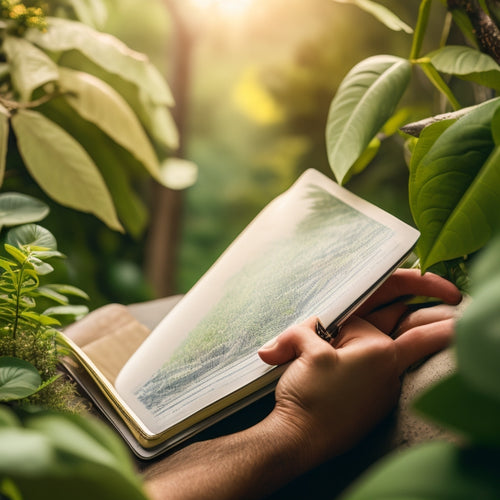
What Powers the Future of Building Energy?
Share
You're on the cusp of a revolutionary shift in building energy, where structures not only minimize their carbon footprint but produce more energy than they consume. Renewable energy sources, like solar power, will fuel electric vehicles and empower communities. Energy-efficient systems, energy storage advancements, and grid optimization will guarantee a reliable supply. Buildings will become net-positive, regenerative, and sustainable, prioritizing occupant well-being and connection to nature. As you explore the future of building energy, you'll discover innovative strategies and technologies that are reshaping the industry - and you're just getting started.
Key Takeaways
• Renewable energy sources, such as solar power, are being harnessed to create decentralized energy systems and reduce reliance on fossil fuels.
• Energy-efficient systems, including HVAC upgrades and building envelope optimization, are being implemented to minimize energy consumption in commercial buildings.
• Energy storage system advancements, such as Lithium-ion and solid-state batteries, are ensuring a reliable energy supply and balancing energy demands.
• Grid optimization and resilience are being achieved through advanced technologies, smart grids, and microgrid design to manage energy distribution efficiently.
• Sustainable building practices, including biophilic design, natural ventilation, and urban albedo management, are minimizing environmental footprint and enhancing occupant well-being.
Harnessing Renewable Energy Sources
As we shift towards a carbon-neutral future, harnessing renewable energy sources is crucial for reducing our reliance on fossil fuels and mitigating the devastating effects of climate change.
You'll be at the forefront of this revolution, driving the shift to a cleaner, more sustainable energy landscape.
By embracing renewable policies, you'll empower communities to take control of their energy futures. Energy democracy is within reach, where local, decentralized energy systems give people a stake in their energy production.
You'll be part of a movement that's redefining the way we generate, distribute, and consume energy.
Together, we can create a future where energy is clean, affordable, and accessible to all.
Commercial Building Energy Efficiency
As you explore commercial building energy efficiency, you'll find that implementing the right strategies can make a significant impact on reducing energy consumption.
By optimizing the building envelope and upgrading HVAC systems, you can create a more sustainable and cost-effective building.
It's time to explore the key points that will help you achieve this goal, starting with energy efficiency strategies, building envelope optimization, and HVAC system upgrades.
Energy Efficiency Strategies
Implement energy-efficient systems and solutions to reduce your commercial building's environmental footprint and operating costs. One important step is to conduct an energy audit to identify areas of improvement. This will help you pinpoint opportunities to optimize energy use and develop a detailed plan to achieve your sustainability goals.
| Energy Efficiency Strategies | Benefits |
|---|---|
| Energy Audits | Identify energy-saving opportunities |
| Behavioral Change | Encourage energy-conscious habits |
| Energy-Efficient Equipment | Reduce energy consumption |
Building Envelope Optimization
By upgrading your building's envelope - the physical barrier between indoors and outdoors - you can greatly reduce heat loss, minimize air leaks, and create a more comfortable, energy-efficient space.
As you optimize your building's envelope, pay attention to thermal bridging, where heat escapes through gaps and cracks. Seal these gaps to prevent heat loss and reduce your energy bills.
Additionally, prioritize air tightness by ensuring all openings, including windows and doors, are properly sealed. This will prevent heated or cooled air from escaping, reducing the load on your HVAC system.
HVAC System Upgrades
You can further reduce your building's energy consumption and carbon footprint by upgrading your HVAC system, which accounts for nearly 40% of a commercial building's energy usage.
By incorporating advanced technologies and innovative designs, you can greatly improve your building's energy efficiency. For instance, you can integrate high-efficiency boilers, chillers, and air-handling units to reduce energy waste.
Additionally, consider implementing advanced air quality sensors to monitor and control indoor air quality, ensuring a healthier environment for occupants.
Solar Power for Electric Vehicles
When exploring the potential of solar power for electric vehicles, you'll need to take into account the infrastructure needed to support widespread EV adoption, including the development of charging stations that can handle increased demand.
You'll also need to contemplate how to integrate renewable energy sources into the grid, ensuring a reliable and sustainable supply of power.
EV Charging Infrastructure
Solar power is revolutionizing EV charging infrastructure, allowing drivers like you to refuel their electric vehicles with clean, renewable energy. As you charge your car, you're not only reducing your carbon footprint but also contributing to a sustainable future.
The design of EV charging stations is pivotal in this shift. Charging Station Design must prioritize accessibility, efficiency, and user experience. Urban Planning Strategies play an essential role in integrating these stations into existing infrastructure, ensuring seamless integration with public transportation and urban development.
Renewable Energy Sources
Over 70% of the world's energy could be harnessed from renewable sources by 2050, and tapping into solar power is essential for a smooth shift to electric vehicles. As you join the electric revolution, you're part of a movement that's redefining energy democracy.
Renewable incentives are driving this change, empowering you to take control of your energy future. By leveraging solar power for your electric vehicle, you're reducing your carbon footprint and contributing to a cleaner environment. You're also part of a community that's shaping the future of building energy.
Grid Load Management
By charging your electric vehicle with solar power, you're not only reducing your carbon footprint but also helping to stabilize the grid during peak hours. As the number of electric vehicles on the road increases, managing the grid load becomes crucial. A Smart Grid system enables efficient distribution of energy, ensuring that the grid can handle the added demand. Peak shaving, a technique used to reduce energy consumption during peak hours, helps alleviate strain on the grid. By integrating solar power and smart grid technology, you're contributing to a more sustainable energy future.
| Time of Day | Energy Demand | Smart Grid Response |
|---|---|---|
| Morning Peak | High | Reduces energy output to prevent overload |
| Midday | Low | Optimizes energy distribution for efficiency |
| Evening Peak | High | Shifts energy load to off-peak hours |
| Night | Low | Charges electric vehicles for next day |
Energy Storage System Advancements
As you integrate more renewable energy sources into your building's power mix, advancements in energy storage systems are essential to ensuring a reliable, efficient, and resilient energy supply.
You're likely familiar with Lithium-ion batteries, but did you know that Lithium innovations are continually improving? For instance, solid-state batteries promise even greater energy density and safety.
Meanwhile, Flow Batteries are gaining traction for their scalability and long-duration energy storage capabilities. These advancements are vital for balancing your building's energy demands, reducing peak loads, and providing backup power during outages.
Grid Optimization and Resilience
You'll need a smart, responsive grid to fully leverage your building's renewable energy sources and energy storage systems, and that's exactly what advanced grid optimization and resilience technologies can provide.
These technologies enable real-time monitoring and management of energy distribution, ensuring that your building's energy needs are met efficiently and sustainably.
With microgrid design and power forecasting, you can predict and manage energy demand, reduce peak consumption, and optimize energy storage. This means you'll have greater control over your building's energy usage, reducing costs and environmental impact.
Building a Sustainable Future
How will you harness the power of innovation to create a sustainable future where buildings not only minimize their environmental footprint but also become net-positive contributors to the ecosystem? By embracing green architecture and urban planning, you can design buildings that produce more energy than they consume, creating a regenerative impact on the environment.
| Sustainable Strategies | Benefits | Applications |
|---|---|---|
| Green Roofs | Insulation, Stormwater Management | Urban Heat Island Mitigation |
| Solar Facades | Renewable Energy, Aesthetic Appeal | Building-Integrated Photovoltaics |
| Biophilic Design | Improved Air Quality, Occupant Well-being | Natural Ventilation, Daylighting |
| Urban Albedo Management | Heat Island Reduction, Energy Efficiency | Cool Pavements, Green Spaces |
Frequently Asked Questions
How Can Energy-Harvesting Buildings Reduce Urban Air Pollution?
As you design energy-harvesting buildings, you'll reduce urban air pollution by integrating Clean Facades that absorb pollutants and Urban Canopies that purify the air, creating a healthier, more sustainable urban environment that you control.
Can AI Optimize Energy Consumption in Commercial Buildings?
As you explore AI's role in optimizing energy consumption, research suggests it can reduce energy waste by up to 20%. You can leverage AI-driven Predictive Maintenance and Energy Audits to streamline commercial building operations, cutting costs and emissions while fostering a sustainable future.
What Role Do Electric Vehicles Play in Building Energy Management?
As you incorporate electric vehicles into your building's energy management, you'll enable Vehicle-to-Grid tech, allowing EVs to feed energy back into the grid, and smart EV Charging systems to optimize energy distribution, putting you in control of a sustainable future.
How Do Energy Storage Systems Handle Power Grid Fluctuations?
You're at the forefront of a sustainable future, and it's essential to understand how energy storage systems handle power grid fluctuations. They maintain grid resilience by regulating frequency, guaranteeing a stable supply and paving the way for a collaborative, eco-friendly tomorrow.
Can Green Buildings Truly Be Carbon Neutral and Sustainable?
As you aim for carbon neutrality, you'll find that sourcing sustainable materials, optimizing water efficiency, adhering to progressive building codes, and influencing occupant behavior are essential steps, alongside mindful land use, to create truly green buildings that benefit both people and the planet.
Related Posts
-

Why Choose Recycled Paper for Earth-Conscious Business?
By choosing recycled paper, you'll greatly reduce your business's environmental impact. You'll lower your carbon foot...
-

7 Solar-Safe Window Solutions for Earth-Conscious Homeowners
As an earth-conscious homeowner, you're likely keen to find solar-safe window solutions that align with your values. ...
-

5 Ways Geothermal Power Boosts Electric Vehicle Efficiency
You're likely unaware that geothermal power can greatly enhance your electric vehicle's (EV's) performance, range, an...


